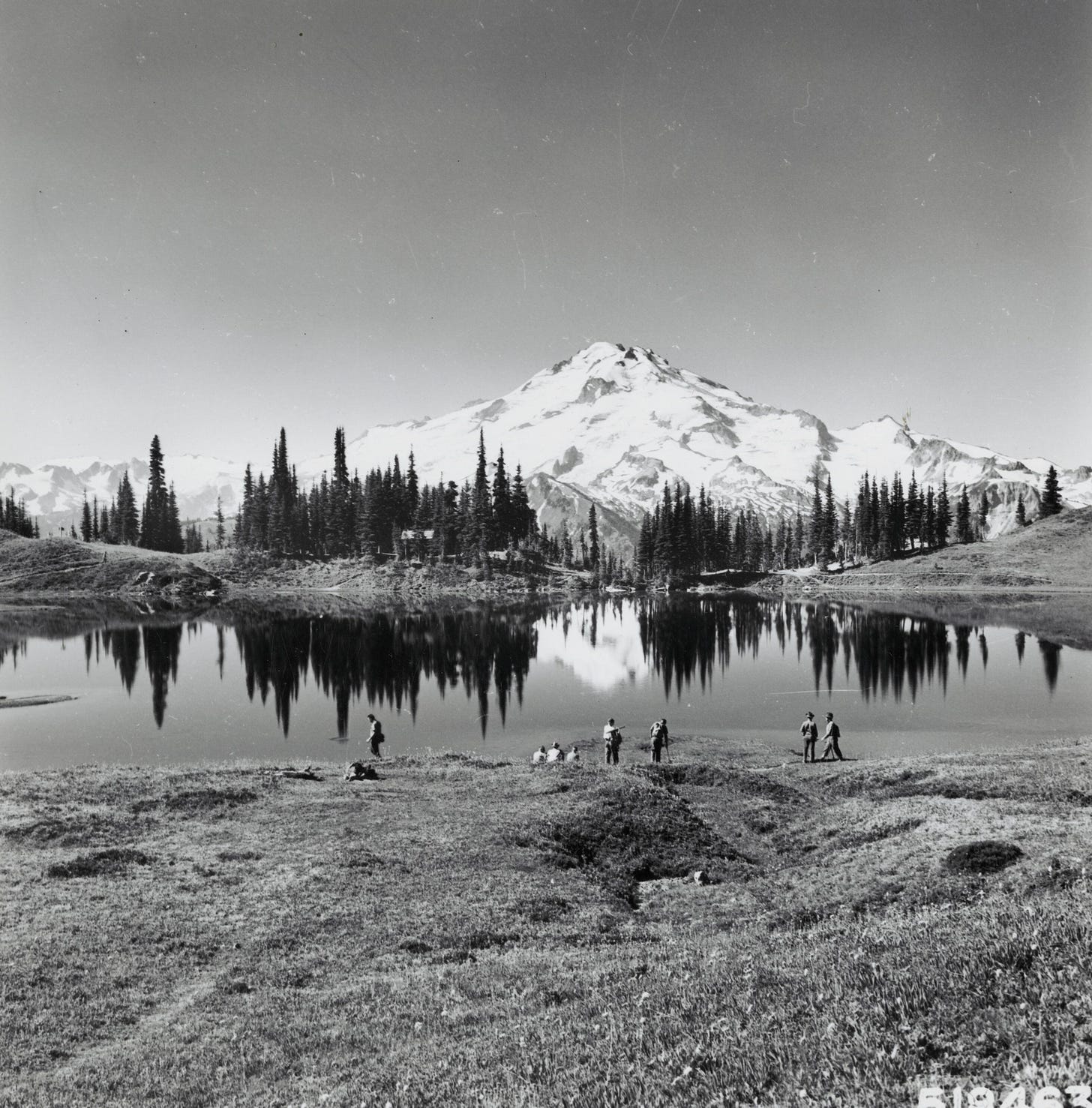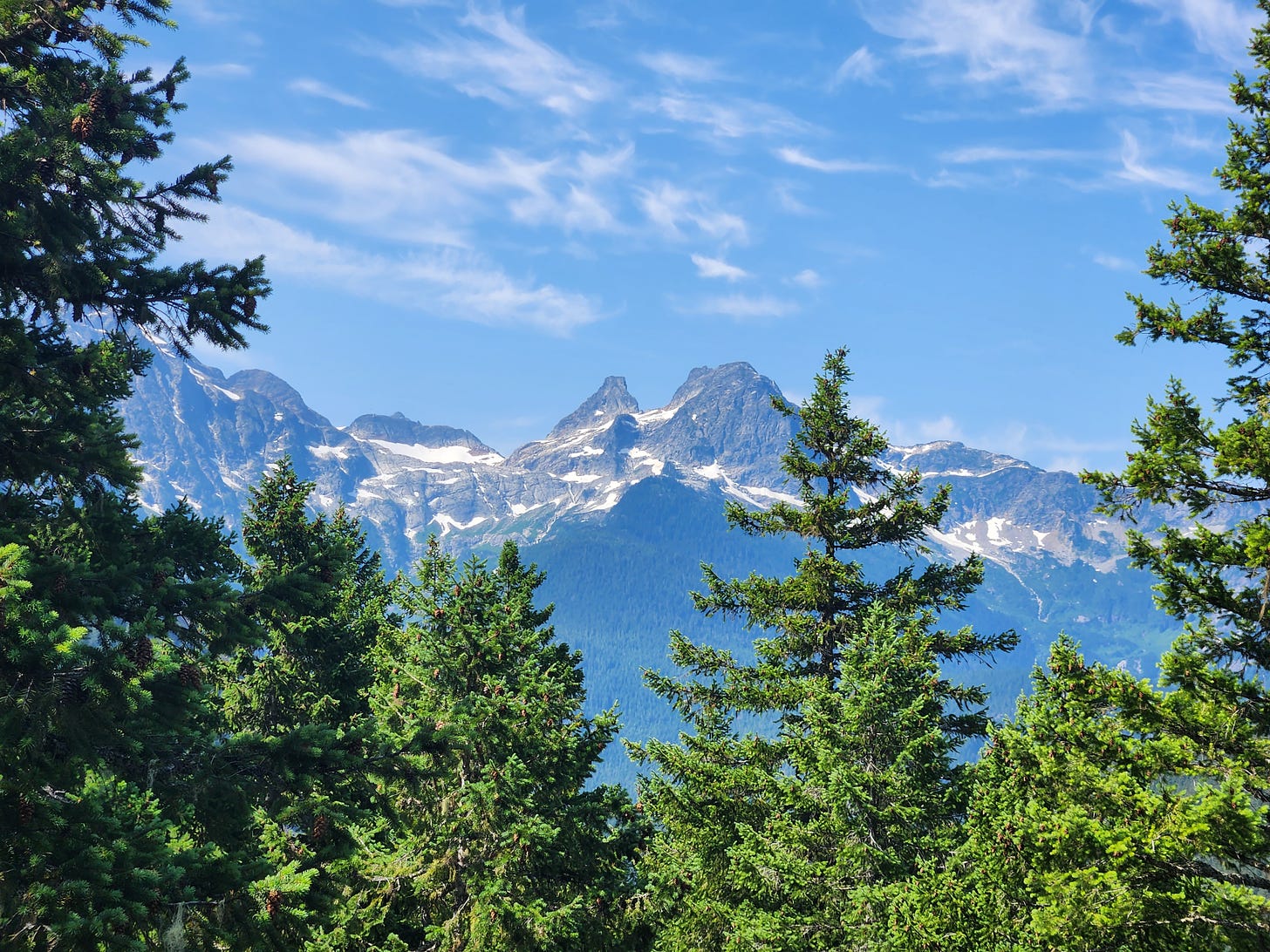How a Book Contributed to Conservation Victory
Looking at Harvey Manning's The Wild Cascades (1965)
When you work as a writer and your cause is wilderness, you might take on impossible assignments because of your passions. If you do, you might unexpectedly create a classic book that exemplifies a cause and a time so well that it almost perfectly preserves the past.
Harvey Manning (1925-2006) was such a writer; The Wild Cascades: Forgotten Parkland (1965) was such a book. For this week’s trip to The Library, I dive into it. Read on!
The Assignment
In March 1965, David Brower, the executive director of the Sierra Club, asked Harvey Manning, a Northwest-based raconteur and tireless backpacker and lover of mountains, to write a book about the North Cascades. Manning knew the area, understood the risks to these wild mountains, and comprehended the politics of preservation in play, so the assignment would be easy.
The catch? Brower wanted the manuscript in June.
The book would be part of an experimental, but successful, series of Exhibit Format books published by the Sierra Club starting in 1960. Brower used his background in publishing to pioneer these books. They stood out in several ways. They were large. The Wild Cascades is 10.5 inches by 13.5 inches. They included beautiful photographs, soon in color, filling those expansive pages with green forests and blue mountains, bringing the bright, wild landscapes into the drab living rooms of anyone who purchased a book.
The purchase price was the other new thing. The first books cost $15, and once color photos were added, it rose to $25. Today, that’s the equivalent of a little more than $200. Think of the last time you spent $200 dollars on a book. Rarely, if ever, right? These books, however, sold well.
Manning met the deadline, and The Wild Cascades included prose from Manning, Brower, and Justice William O. Douglas; poetry from Theodore Roethke; and photographs from Ansel Adams, Philip Hyde, Bob and Ira Spring, and more. It’s a volume packed with powerful images of all kinds.
The Cause
The context in which The Wild Cascades emerged explains its shape and its impact.
After decades with various protective designations, the US Forest Service created Glacier Peak Wilderness in 1960. Four years later, when Congress passed the Wilderness Act, Glacier Peak Wilderness became one of the inaugural areas as a congressionally-designated wilderness.
Glacier Peak sat in the heart of the wild North Cascades, but vulnerable areas remained unprotected. Timbered river valleys pulled at timber companies’ interest along all the edges. And at Miners Ridge, within the protected wilderness, copper deposits controlled by Kennecott Copper Corporation, tempted the company to open a mine—a possibility permissible by compromises written into the wilderness law.
In the decade before Manning wrote The Wild Cascades, Northwest conservationists grew increasingly alarmed by the threats and assertive about their interests in protecting these places.
How to do that? First, gather attention about the threats, because a galvanized public can encourage politicians to act. Second, conservationists advocated turning the North Cascades into a national park. An anecdote Manning related showed how both these strategies worked together: Senator Henry “Scoop” Jackson told Northwest conservationists, “I can’t give you a park. . . . But if you get up a big enough parade, I’ll step out front and lead it on in.”
National parks often developed—overdeveloped, critics would say—wild places, so conservationists who wanted the North Cascades protected came to the park somewhat reluctantly. But by the mid-1960s, they distrusted the Forest Service so much, thinking it had been captured by the timber industry, they believed a national park was their only choice.
And while being protected in a national park did not preclude the mining at Miners Ridge, park status would make it politically more difficult. Once the park path was chosen, mobilizing public opinion to transform the North Cascades into a national park began. And The Wild Cascades played an important role.

The Book’s Message
Manning was a master at effective prose, knowing exactly what to do to hit the reader squarely in the chest. He told personal stories of hiking these mountains. He surveyed the diverse landscape. He painted remarkable pictures with his words, bringing readers along. Among my favorite passages is this:
On another bright and windy day one may climb Miners Ridge through red heather, white heather, and yellow heather, all in fresh bloom, all mixed together, and the slope so steep that the red bells, the white bells, the yellow bells are only inches away from eyes and nose, and at length one seems not to be climbing upward on feet but swimming upward with hands and knees and elbows, affecting a butterfly stroke through a multi-colored froth of silent bells.
Such prose, Manning surely hoped, would inoculate readers from wanting to turn these landscapes into multiple-use workhorses where profit might be extracted to grow a company’s quarterly returns and bolster the nation’s GDP.
Manning turned his final two chapters away from the natural world and hit politics hard. Having already set the physical scene, now Manning established the political stage—and stakes. He explained the history, policies, and proposals. Manning took it a step further to defuse opponents’ arguments. The book begins by describing hiking in the forests; it ends by advocating policy change.
All writing seeks to persuade, yet the transformation of Manning’s nature writing in the Exhibit Format book into a political tract is a remarkable example of showing what was at stake. And it demonstrates how writers were in the fight.1
Closing Words
This newsletter is adapted from my book An Open Pit Visible from the Moon, which examines the Miners Ridge story in detail. Last week, I published a short story about Justice Douglas’s role in a protest in this campaign that can be found here.
Paid subscribers will see a new interview published before the next regular newsletter. You can upgrade now for full, timely access to it. It will be worth it.
As always, you can find my books, and books where some of my work is included, at my Bookshop affiliate page (where, if you order, I get a small benefit).
Taking Bearings Next Week
The Wild Card is next week’s offering, and that means it could be anything. Stay tuned!
The national park was created in 1968, although it did not encompass Miners Ridge. Kennecott did not, however, develop its mine.





